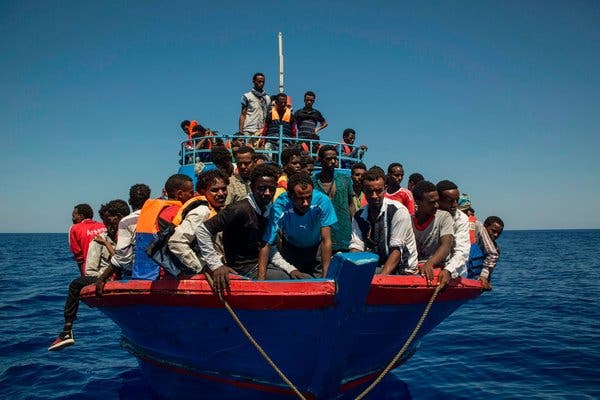By Akanimo Sampson
The International Organisation for Migration (IOM) has reported the death of 683 migrants on the three main Mediterranean Sea routes through 199 days of this year which represents 47 per cent of the total (1,449 deaths) confirmed during the same period in 2018.
The United Nations agency also reports that 34,226 migrants and refugees have entered Europe by sea through July 17, roughly a 34 per cent decrease from the 51,782 arriving during the same period last year.
Arrivals this year to Spain and Greece are each well over 10,000 individuals (28,356 combined) accounting for almost 83 per cent of the region’s total, with the balance arriving in much smaller numbers to Italy, Malta and Cyprus. Arrivals to Greece are 1,352 ahead of last year’s totals from this time last year. Arrivals to Spain are 6,589 fewer.
According to IOM Rome’s Flavio Di Giacomo, who was citing official Ministry of Interior figures, 3,186 migrants have arrived by sea to Italy in 2019. During the same period this year 4,023 migrants or refugees have been returned from the Central Mediterranean route back to Libya since the start of the year.
IOM Spain’s Ana Dodevska reported on Thursday on a very busy week with arrivals to Spain, through 17 July, now reaching 12,064 men, women and children.
Based on the latest report published by the Spanish Ministry of Interior on irregular arrivals to Spain, Spanish authorities have registered a total of 11,703 arrivals through the Western Mediterranean and the Western African Route, in the period from January 1 to July 15, 2019.
According to IOM estimates based on publicly available information, the sea arrivals to the Coast of Andalusia in the last few days added another 361 individuals to that total.
While monthly arrivals to Spain are lower this year over all (see chart below), fatalities on the Western Mediterranean route remain high – with 204 deaths reported through a little more than six months of this year, compared to 296 at this time in 2018.
The latest fatality was recorded on July 17. The death of a woman was reported by the NGO Caminando Fronteras, which runs a hotline for people in distress attempting the sea crossing from North Africa.
During a search and rescue operation conducted by Spanish rescue services, 73 people – including 23 women – were saved from a boat sinking in the Alborán Sea. The rescuers also recovered the remains of a woman. In total, 276 migrants were rescued from four boats that same day: three boats reached by Spanish rescue services, who took the survivors to Almería; a fourth boat was reached by the Moroccan Navy.
It was also a busy week on the Eastern Mediterranean route. IOM Greece’s Christine Nikolaidou noted on Thursday (18/07) that the Hellenic Coast Guard (HCG) reported at least 26 incidents requiring search and rescue operations off the islands of Lesvos, Chios, Samos, Kos, Samothraki, Symi, Farmakonisi and Limnos and off the port of Alexandroupolis. The HCG rescued a total of 814 migrants and transferred them to the respective ports.
Those rescues and other landings during the past week bring to 16,292 the total number of irregular migrants and refugees IOM has recorded arriving by sea to Greece this year (see chart below).
That’s an increase of over 1,500 irregular migrants over the past seven days. IOM noted that the 349 migrants arriving on Saturday (July 13) – mainly to Lesvos, Samos and Chios – marked the largest single day arrival total since March 27, 2018, when 368 landed.
October 20, 2015 was the busiest day on record, according to IOM data. That day 12,558 migrants arrived to Greece, part of the largest migration inflow since the beginning of 2015, occurring from October 17 to October 21, when approximately 48,000 refugees and migrants crossed from Turkey to the Greek islands in just five days.
2019 is the sixth year of IOM’s efforts to systematically record deaths on migration routes worldwide through its Missing Migrants Project.
Since the beginning of 2014, the project has recorded the deaths of 32,362 individuals, including 1,405 in 2019 (see chart below); although due to the challenges of collecting information about these people and the contexts of their deaths, the true number of lives lost during migration is likely much higher.
Missing Migrants Project records should only be viewed as indicative of the risks associated with migration, rather than representative of the true number of deaths across time or geography.
On the US-Mexico border, the Missing Migrants Project team recorded the deaths of five people since last week’s update. On July 11, a 33-year-old Guatemalan man was reported missing by a group of migrants who were travelling with him in South Bexar County, Texas.
According to their testimony, he felt sick and could not continue his journey. A search operation was launched by the Sheriff’s Office, but as of 18 July his remains had not been located. The drownings of four people were reported in the Río Bravo: US Border Patrol agents recovered the remains of two men – one near Brownsville, Texas, and another near Eagle Pass, in Texas. On the south bank of the river, Mexican civil protection authorities located the remains of two young Mexican men.
In total, at least 455 people have lost their lives in the Americas in 2019, compared with 287 recorded through this point in 2018.
Missing Migrants Project data are compiled by IOM staff based at its Global Migration Data Analysis Centre but come from a variety of sources, some of which are unofficial. To learn more about how data on migrants’ deaths and disappearances are collected.

